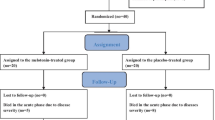Abstract.
Background and aim: New biological response modifiers are usually tested in reductionistic, pharmacological animal models by the determination of mechanistic endpoints (mortality rate, cellular/physiological parameters). In the meantime, quality of life had become an important endpoint in clinical trials but adequate animal experiments are very rare. The aim of this study was to demonstrate alterations in the behavioural response of septic rats due to a prophylaxis with cytokine (G-CSF) plus antibiotics. Methods: Sickness behaviour (locomotor activity, circadian rhythms of blood pressure, heart rate and temperature) was determined by the use of radio telemetry. Complex animal experiments in rats were performed including anaesthesia, antibiotic and G-CSF prophylaxis, volume substitution, laparotomy, contamination and infection with human faecal suspension and postoperative analgesia. Results: Prior to infection, rats showed circadian rhythm in locomotor activity, blood pressure, heart rate and temperature. Sham operation did not alter these parameters significantly. Immediately after abdominal contamination and infection, locomotor activity was strongly reduced and circadian rhythm was lost in all parameters. Body temperature showed a continuous rise, peaking 38 h after infection. Untreated animals died in 63% (8/14) of cases. Antibiotic prophylaxis blunted the febrile response and markedly reduced mortality to 20% (2/10) or 0% (0/10) using G-CSF plus antibiotics. Blood pressure and heart rate were increased in parallel with the rise in temperature. These early physiological changes were not prevented by prophylaxis, but normal behaviour was restored faster with G-CSF plus antibiotic prophylaxis. Conclusions: In septic rats, sickness behaviour (locomotor activity) is significantly improved in parallel to the mortality rate by a prophylaxis with G-CSF plus antibiotics. Sickness behaviour can be considered as an equivalent to human quality of life.
Similar content being viewed by others
Author information
Authors and Affiliations
Additional information
Electronic Publication
Rights and permissions
About this article
Cite this article
Bauhofer, A., Witte, K., Celik, I. et al. Sickness behaviour, an animal equivalent to human quality of life, is improved in septic rats by G-CSF and antibiotic prophylaxis. Langenbeck's Arch Surg 386, 132–140 (2001). https://doi.org/10.1007/s004230100206
Received:
Accepted:
Issue Date:
DOI: https://doi.org/10.1007/s004230100206




